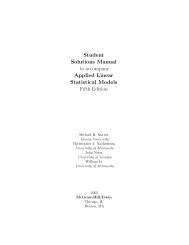Journal of Film Preservation - FIAF
Journal of Film Preservation - FIAF
Journal of Film Preservation - FIAF
Create successful ePaper yourself
Turn your PDF publications into a flip-book with our unique Google optimized e-Paper software.
Stagestruck <strong>Film</strong>maker:<br />
D.W. Griffith and the American Theatre<br />
Eileen Bowser<br />
Publications<br />
Publications<br />
Publicaciones<br />
David W. Griffith directing.<br />
Historien du théâtre, collaborateur de<br />
l’édition Griffith du BFI, David Mayer<br />
nous livre ici un portrait du grand<br />
cinéaste comme artiste plongé dans<br />
le théâtre populaire du début du XX e<br />
siècle.<br />
Les premiers écrits sur le cinéma ont<br />
fréquemment insisté sur les différences<br />
entre théâtre et cinéma de manière<br />
à prouver que ce dernier était une<br />
forme d’art entièrement nouvelle,<br />
correspondant à l’âge moderne. L’essai<br />
de Nicholas Vardac (Stage to Screen,<br />
1949) et, plus récemment, celui de<br />
Ben Brewster et Lea Jacob (Theatre to<br />
The Giornate del Cinema Muto, held in Italy each October, has now<br />
completed more than a decade <strong>of</strong> The Griffith Project. This project,<br />
dedicated to the showing <strong>of</strong> all <strong>of</strong> the master’s films, has resulted in a<br />
remarkable film-by-film in-depth study by an international group <strong>of</strong><br />
scholars, published by the British <strong>Film</strong> Institute in 12 volumes and edited<br />
by Paolo Cherchi Usai. On this solid ground the scholarship on D. W. Griffith<br />
continues to expand. David Mayer, the author <strong>of</strong> Stagestruck <strong>Film</strong>maker,<br />
contributed his expertise as a theater historian to The Griffith Project and<br />
now <strong>of</strong>fers us his view <strong>of</strong> Griffith as a filmmaker immersed in the popular<br />
theater <strong>of</strong> the early 20th century.<br />
Early writers on cinema <strong>of</strong>ten sought to<br />
differentiate theater and cinema in order<br />
to establish that the latter is an entirely<br />
new art form <strong>of</strong> the modern age. The<br />
never-ending debate on the relationship<br />
<strong>of</strong> film and theater was addressed in 1949<br />
by Nicholas Vardac, who argued in Stage<br />
to Screen that theatrical trends in the<br />
late 19th and early 20th century in the<br />
direction <strong>of</strong> spectacle and illusionism led<br />
to the formation <strong>of</strong> cinema because <strong>of</strong> its<br />
superior capacity to exploit these qualities.<br />
In more recent times, Ben Brewster and Lea<br />
Jacobs’ Theatre to Cinema (1997) looked to<br />
pictorialism in theater as a major influence<br />
on mise-en-scène in cinema, especially in<br />
the period when the feature film began<br />
to arrive. David Mayer, an accomplished<br />
theater historian, chose to write about just<br />
one filmmaker, albeit a very important one, to show us how he was formed<br />
by the popular theater <strong>of</strong> his youth, and influenced by it to the end <strong>of</strong> his<br />
film career.<br />
Mayer gives us a thorough description <strong>of</strong> the theater in America as it existed<br />
during Griffith’s young days and as he might have witnessed it, a history<br />
that will be useful to all film historians <strong>of</strong> that period, not only Griffith<br />
scholars. He describes the origins and traces the routes <strong>of</strong> the popular<br />
theater over the fast-spreading railroad lines in the late 19th and early 20th<br />
century. In Kentucky, Louisville became an important railroad destination<br />
and one <strong>of</strong> the active centers <strong>of</strong> theatrical life. Mayer speculates on the<br />
plays, managers, and players Griffith may have known as an adolescent<br />
in Louisville. He explores Griffith’s theatrical experiences and contacts<br />
as he struggled with a none-too-successful acting career, and he also<br />
describes Griffith’s little-known excursion into vaudeville and his efforts as<br />
a playwright.<br />
71 <strong>Journal</strong> <strong>of</strong> <strong>Film</strong> <strong>Preservation</strong> / 81 / 2009
















